Between April 2nd and 16th 2022, a group of students from the BA program “Geographies of International Development, Focus Africa” travelled to Tanzania for a learning experience. The idea was to break with the traditional model of the field trip that has become a mainstay of geographical education over many decades, and rather put the work of Tanzanian scholars at the center of the learning experience. How have Tanzanians themselves produced geographical knowledge about their country? What topics matter to them? How can more equal encounters between Northern and Southern scholars be organized? These questions are embedded into a wider pedagogical strategy that encourages students to develop keywords. Through these we cannot only problematize certain social phenomena, but which also serve as compass for the learning experience on the ground.
| Supervisor | Prof. Dr. Stefan Ouma |
| Participants | Geogrpahies of International Development, Focus Africa: Felix Brentrup, Valerie Dagenbach, Henrike Haggeney, Anton Scheit, Melanie Schwarzfischer, Jakob Trappe, Carolin Voß |
| Kontakt | LS.WiGeo@uni-bayreuth.de |
| Download | Reader Tanzania Excursion |
Keywords
The following text presents the keywords. Each section begins with a general introduction, after which it zooms into the Tanzanian context and traces the ‘materialization’ of a keyword in a specific geographical setting. Each student then presents the script that should guide through a day and structure the encounters with Tanzanian experts – researchers and many more. It closes with an ex-post analysis of the day, aimed at enhancing the student’s, capacities for critical reflection. Several Tanzanian scholars have made key contributions to these keywords. We are very grateful to the many Tanzanians and people based in Tanzania who have helped us organize this trip.
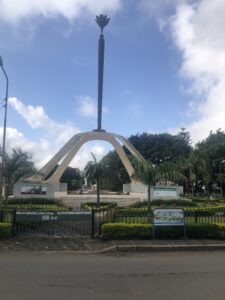
Photo: Arusha Declaration Monument (own picture)
Author: Freda Louwes
Each city has its own character. It is individual in its structure and position. Basic functions of one city may be applied to another, nevertheless, no two cities are the same. We differentiate several types of cities ranging from industrial cities, market cities, university cities over cities of culture to political cities. With growing urbanization and the development of megacities, geographers have faced the problem of one city fitting more than one type. The perception of cities has become a conceptual issue (Calder 2021). Consequently, a new term had to be found that best described the importance of cities without reducing them to only one characteristic. Saskia Sassen introduced the concept of the global city, a concept that realizes the multipurpose of cities and acknowledges the relational importance of them in a global economic and political arena (Sassen 2001: 169).
Political Cities are characterized by their political influence. Oftentimes major political cities are the equivalent to capital cities, however, in the case of Arusha another explanation can be found. Political influence cannot be reduced to the mere residence of national governments, rather it is extended by regional and global headquarters of international organizations. In Tanzania, the hub for regional integration and international cooperation is Arusha.
Read more: Political City
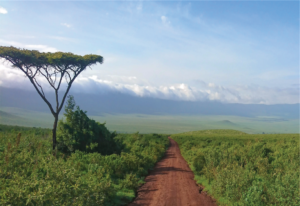
Photo: Ben Preater, Unsplash
Author: Anton Scheit
Coloniality as a concept originally derives from the late 1990s, a period when scholars increasingly identified long-lasting ‘left-overs’ of colonialism in former colonies. Initially, the concept had been applied in a Latin-American context but has then become a key concept examining sustained spheres of colonialism on a global scale (Maldonado-Torres 2007: 243). Coloniality takes ongoing colonial influences into account and links them to factors that were installed during colonialism. Thus, the concept facilitates differentiated examinations of and – by distinction – non-Eurocentric perspectives on asymmetric power structures which still impede a society’s emancipatory potential for autonomy (Escobar 2007: 180).
In the past decade, pastoralists in Tanzania’s north have experienced a new wave of violent evictions in the course of the government’s aim to expand wildlife tourism. The district of Loliondo lies around 300 km northwest of Arusha. As Weldemichel (2020) carried out and (inter)national newspapers repeatedly have addressed, several evictions from 2009 until 2017 took place in Loliondo leaving thousands of Maasai people homeless and dispossessed.
Read more: Coloniality of Conservation
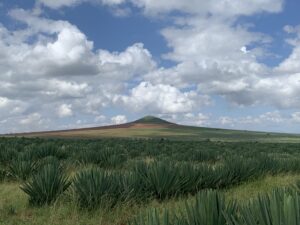
Photo: Sisal Plantation Tranzania (own picture)
Author: Carlin Voss
The plantation and its organizational structure, facilitating colonial exploitation, have cast a long shadow in colonized areas such as Tanzania. An exhaustive definition of the word ‘plantation’ is difficult to give, due to numerous factors regarding topics like degrees of industrialization, labor regime, and property rights (Watts 2009: 542). In general, plantations can be differentiated from other agricultural operations based on “size, authority structure, crop or labour force characteristics” (ibid.: 543). The study of plantations and the power structures that were simultaneously established must entail a reflection on the position of plantations in their wider social context as well as in their relation to the history of exploitation and capitalist accumulation.
During the period of German colonization, the area that is now Tanzania came to a position of immense significance regarding the international trade of sisal fiber (Sabea 2008: 411). The number “of sisal plantations rose from 1 in 1893 to 54 by 1913, and production jumped from a mere 0.6 tons in 1898 to 20,835 tons in 1913, comprising almost 30 percent of the total value of GEA [German East Africa] exports” (ibid.).
Read more: Plantation
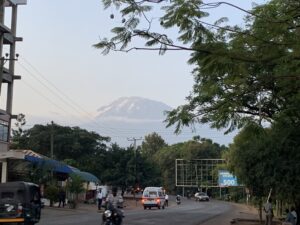
Photo: Mount Kilimanjaro (own picture)
Author: Melanie Schwarzfischer
The concept of resilience is widely used and applied in many different disciplines ranging from natural sciences to social sciences. In broad terms, the concept of resilience describes “the capacity of ecosystems, individuals, organizations or materials to cope with disruption and stress and retain or subsequently regain functional capacity and form” (Hudson 2010: 2). The concept of resilience has been applied in tourism studies since the number of crises affecting the tourism industry has been rising dramatically over the past years. Due to the globalized nature of tourism, the dependence on tourist flows and the reliance on the tourists’ safety, the tourism sector is very vulnerable to crises (Jiang et al. 2019: 882 ff.). To improve the sustainability of tourism management and the ability to cope with uncertainties, the concept of resilience can be utilized.
The tourism landscape in Tanzania is quite diverse, ranging from wildlife safaris, mountain and trekking activities to community tourism and beach tourism (Mauly Tours 2022). But all in all, the tourism industry is highly dependent on the natural capital of the regions and the maintenance of national parks in Tanzania.
Read more: Resilience
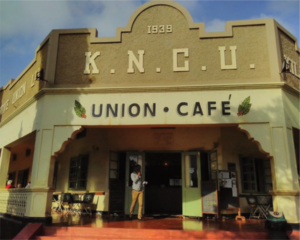
Photo: K.N.C.U Union Café (Ouma, 2016)
Author: Henrike Haggeney
Called a “first-choice business model for locally based, locally controlled community development”, cooperatives have been praised for having the potential to uplift far more people out of poverty into the “socio-economic mainstream” than other business structures while having the advantage of lifting groups instead of individuals (Majee and Hoyt 2011: 51). The aims of cooperatives are to serve a broad set of socio-economic objectives such as self-help, grassroots participation, income distribution, exploitation of economies of scale, social control over resources and productivity increase (Sumelius et al. 2013: 9-10).
Tanzania´s cooperative movement today is large in terms of membership numbers, but it makes up just a fraction of its size of the 1950/60s. In 2012, cooperatives in Tanzania had a total membership of 1.6 million (Sumelius et al. 2013: 6). The Tanzania Coffee Board is a government body, responsible for the regulation and control of the coffee sector through issuing licenses for all different activities in the sector. At the official coffee auction in Moshi, licensed exporters buy coffee from the suppliers, which can be either cooperatives or private buyers.
Read more: Cooperative Development
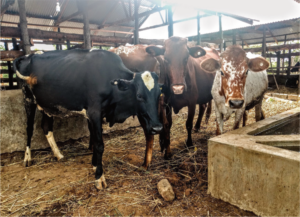
Photo: Improved cattle on the supplier farm (own picture)
Author: Jakob Trappe
Financialisation is described as “the dominant force changing capitalism, shifting the gravity of economic activity from ‘real’ production (primary, manufacturing and services) to finance (investment banking, insurance, arbitrage, asset management, venture capital, currency trading and so on). Even non-financial firms are increasingly oriented towards financial rather than ‘productive’ profits“ (Milberg 2008 cited in Mawdsley 2018: 26). Financialisation has also reached the field of agricultural development with the New Alliance for Food Security and Nutrition in Africa launched by the G7 and the United States Agency for International Development (USAID) in 2012 to lift 50 million African people out of poverty through agri-business investments until 2022 as a reaction to the global food price crisis of 2007/2008 (Brooks 2016: 770). It can be read as a continuation of the old paradigm of connecting smallholders to markets, but now in the new form of value chain interventions (ibid.).
The agricultural sector of Tanzania, which employs nearly 70% of the national workforce and contributes to over 30% of the national GDP, is still very relevant to the national economy (Lupatu 2017). Although the Tanzanian market is perceived to have huge growth potential and there has been a growing interest of investors in the agricultural sector since the early 2000s, Tanzania is not as favored as an investment 91 Tanzania Excursion 2022 destination as Kenya (Lupatu 2017; Ouma & Katundu 2020: 1). This is owing to specific market characteristics and challenges: the dominance of smallholders (owning less than 5 acres of land), lack of infrastructure, currency volatility, overregulation, and a bulky agricultural tax regime with currently 73 different taxes (Lupatu 2017; Ouma & Katundu 2020: 2).
Read more: Financialisation of Agricultural Development
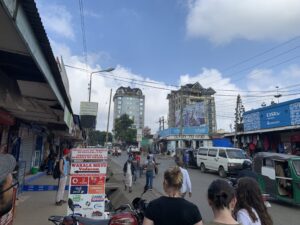
Photo: Machinga Complex, Dar es Salaam (own picture)
Author: Valerie Dagenbach
To keep up with the conditions of the ongoing urbanization process, concepts concerning urban rights and well-being like ‘citizenship’ need to be redefined (DelSesto 2015: 2). The historical idea of citizenship – called conventional citizenship – conveys a passive understanding of citizenship because people receive their citizenship status by having a certain legal status which is documented (ibid.: 2). It is a clearly defined concept that decides who is legally regarded as inclusive or exclusive in a certain political setting and associated rights (Schillinger 2018: 18). Urban citizenship can be understood as a process of inclusion that recreates the urban by producing new social and spatial structures and constituting a new inclusive public. The newly created space reflects the needs and lived realities of the urban inhabitants (DelSesto 2015: 3). Moreover, besides affiliation, which is connected to the status of citizenship, urban citizenship is about certain participation.
Dar es Salaam is Tanzania’s biggest city and counts as one of the fastest-growing cities on the African continent. The increasing urbanization leads to inequalities within the cities like Dar es Salaam. Because urban citizenship is about access and affiliation the concept can be projected onto different dimensions of urban life: mobility, informality, and public space.
Read more: Urban Citizenship
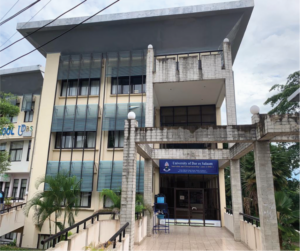
Photo: Building of the UDIEC (own picture)
Author: Felix Brentrup
Entrepreneurial Ecosystem (EE) is a concept developed in the 1990s as a result of a shift away from an individualistic and personality-based view of entrepreneurship towards understanding entrepreneurship as a social process embedded in a local context shaped by cultural, historical, political, economic, and social factors and structures (Friederici et al. 2020: 152; Galperin and Melyoki 2018: 31 ff.). The approach of EE is usually employed in connection with a narrow understanding of entrepreneurship in terms of high-tech and high-growth ventures. Even among African countries, the EE of Silicon Valley is often regarded as the ideal model to aspire to (Friederici et al. 2020: 119; Neumeyer and Corbett 2017: 38).
By far the largest entrepreneurial ecosystem in Tanzania, in terms of number of entrepreneurs and volume of resources, is the one in Dar es Salaam (Galperin and Melyoki 2018: 37). According to the Statistical Business Register Report, in 2015 there were almost three times as many firms in Tanzania’s most populated city as in Mbeya, Morogoro or Ruvuma and more than seven times as many as in the second largest city Mwanza (The United Republic of Tanzania 2016: 25).
Read more: Entrepreneurial Ecosystem
